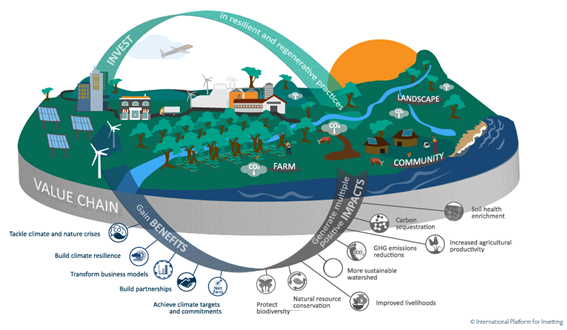

Climate change is accelerating at an alarming rate, with projections pointing to a global temperature increase of 2.7°C by the end of the century, well above the target set by the Paris Agreement. Growing pressure to reduce greenhouse gas (GHG) emissions has led both the public and private sectors to seek more effective solutions, and to adopt more ambitious climate commitments. While many companies turn to carbon offsetting to achieve neutrality, this option is not always sufficient, especially in hard-to-decarbonize sectors such as agriculture. In this context, carbon insetting is emerging as an evolving alternative that proposes a deeper integration of sustainable practices into companies' value chains. This approach aims not only to mitigate emissions but also to promote adaptation to climate change, creating shared value for companies, farmers, and local communities. As such, this mechanism can become a focal point for sectors seeking to move towards sustainability by investing in healthy ecosystems and promoting decarbonization within their value chain.
But what do we mean by insetting? The International Platform for Insetting (IPI) describes insetting projects as "interventions along a company's value chain that are designed to achieve GHG emission reductions and carbon storage, while creating positive impacts for communities, landscapes, and ecosystems".
Broadly speaking, carbon insetting is a strategy that enables companies to reduce their emissions within their own supply chain, focusing on nature-based solutions such as reforestation, agroforestry, renewable energy, and regenerative agriculture. Unlike carbon offsetting, which focuses more on external projects, insetting aims to achieve emission reductions and increased carbon sequestration directly within the value chain, addressing Scope 3 emissions (which have the greatest impact on carbon footprints). In addition to mitigating climate change, insetting projects have a positive impact on local communities, ecosystems, and landscapes associated with the company's value chain. These actions, implemented on farms, in communities, or in the surrounding landscape, not only help companies meet their climate goals, but also strengthen the resilience of their business models by improving the sustainability and quality of natural resources in their supply chain.

Carbon offsetting is based on compensating for the climate impacts by funding external projects unrelated to the company's value chain, generating carbon credits that must be verified by a third party. This approach allows carbon neutrality to be achieved through the purchase of carbon credits, but it has limitations, such as double counting or the lack of additionality, where projects do not generate real emission reductions or were already planned. While it provides a relatively quick solution, offsetting does not directly address emissions within the company's operations.
On the other hand, carbon insetting focuses on reducing emissions within the company's supply chain by implementing nature-based solutions such as agroforestry, regenerative agriculture, and reforestation. Unlike offsetting, insetting allows companies to directly control the impact of their actions, reducing emissions more sustainably and generating additional benefits for local communities and ecosystems. This approach not only focuses on carbon sequestration but also promotes long-term resilience by aligning agricultural practices with sustainability and decarbonization goals. In the agricultural sector, insetting represents a more comprehensive strategy that transforms agricultural practices and strengthens the supply chain against climate change.
The development of an insetting process involves several key steps aimed at reducing emissions within the supply chain. One of them is the identification and implementation of mitigation activities, which may include reducing emissions or increasing carbon sequestration through practices such as regenerative agriculture, which must be monitored on an ongoing basis. Regenerative agriculture projects aim not only to reduce GHG emissions, but also to improve soil health (which has a positive impact on the crops and production itself) and provide other environmental benefits, thus meeting the additionality requirement.
In conclusion, carbon insetting projects in the agricultural sector offer a transformative opportunity for both the companies and the environment. By focusing efforts on carbon reduction and sequestration within the value chain itself, companies not only directly address a significant portion of their Scope 3 emissions (which are often the most difficult to manage), but also strengthen their relationships with suppliers and improve the resilience of their supply chain. In addition, these initiatives promote sustainability by incorporating regenerative agriculture practices that not only reduce greenhouse gas emissions, but also improve soil health and preserve natural resources. In the long term, the benefits extend beyond the environment to create positive social impacts by supporting farming communities and fostering new economic opportunities. This gives companies a competitive advantage by improving land management and conserving natural resources, increasing productivity, and ensuring long-term supply chain stability.
Bahtia V. (March 18, 2022). Climate Action - Explainer: Carbon insetting vs offsetting. World Economic forum. https://www.weforum.org/stories/2022/03/carbon-insetting-vs-offsetting-an-explainer/
Carbon Insetting: a necessary step toward Net Zero? (September 11, 2024). Proba. https://proba.earth/probas-blog/insetting
Lacalle M. (August 22, 2024). The rise of carbon insetting: What is it and why is it important in logistics? https://lune.co/blog/what-is-carbon-insetting
Banerjee, A., Rahn, E., Läderach, P., & Hoek, R. V. D. (2013). Shared value: Agricultural carbon insetting for sustainable, climate-smart supply chains and better rural livelihoods. https://cgspace.cgiar.org/items/212afb94-76a1-46ff-a356-a683df59b9bf
A PRACTICAL GUIDE TO INSETTING. 10 lessons learned and 5 opportunities to scale from a decade of corporate insetting practice (March 2022). International Platform for Insetting. chrome-extension://efaidnbmnnnibpcajpcglclefindmkaj/https://www.insettingplatform.com/wp-content/uploads/2022/03/IPI-Insetting-Guide.pdf